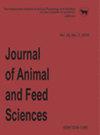干云母果肉渣对日粮添加量的影响。对绵羊采食量、摄食行为、消化率、氮平衡和瘤胃pH值的影响
IF 1.5
4区 农林科学
Q3 AGRICULTURE, DAIRY & ANIMAL SCIENCE
引用次数: 0
摘要
. 本试验旨在评价在羔羊日粮中添加干树阴果肉渣(DUFR)的效果。分别为0、8、16、24和32%。选取25只未阉割的公羊羔(40.8±4.17 kg),随机分为不同处理,观察其摄入、消化、氮平衡和摄食行为。测定5 d后瘤胃pH、瘤胃液氨氮及总原虫丰度。干蛋白(CP)、总可消化营养物质(TDN)、CP消化率、瘤胃氨氮、氮采食量均不受DUFR的影响。然而,中性洗涤纤维(NDF ap)采食量、进食和反刍时间、咀嚼量/天和瘤胃pH随DUFR包合量的增加呈线性增加,脂肪和非纤维性碳水化合物(NFC)采食量、DM、NDF和TDN消化率、空转时间、DM/ bola咀嚼量(g)和原生动物数量线性降低DUFR包合量。然而,不建议将高达32%的DUFR添加到精料饲料中,因为这会降低营养物质的消化率和氮平衡,影响生产性能。本文章由计算机程序翻译,如有差异,请以英文原文为准。
Effects of dietary inclusion of dry umbu fruit pulp residue
(Spondias tuberosa Arr. Cam) on intake, ingestive behaviour,
digestibility, nitrogen balance and ruminal pH in sheep
. The aim the present to evaluate the effect of dietary inclusion of dry umbu pulp fruit residue (DUFR) into lamb diet. DUFR ground corn at 0, 8, 16, 24 and 32% of the total diet. To evaluate intake, digestion, nitrogen (N) balance and ingestive behaviour, twenty-five uncastrated male lambs (40.8 ± 4.17 kg) were randomly distributed among treatments for 21 days. To evaluate ruminal pH, ammonia N in the rumen fluid and total protozoa abundance, five days. The of dry protein (CP) total digestible nutrients (TDN), CP digestibilities, ruminal ammonia N, N-intake and not linearly affected by the inclusion of DUFR. However, a linear increase in neutral detergent fibre (NDF ap ) intake, time spent eating and ruminating, the number of boluses chewed/day, and ruminal pH in sheep with the increase of DUFR inclusion were The intake of EE and non-fibrous carbohydrates (NFC), digestibility of DM, NDF and TDN, time spent idling, amount (g) of DM/ bolus chewed, and protozoa count decreased linearly dietary inclusion of DUFR. The inclusion of up to 32% DUFR instead of ground corn eating and rumination time, however, it is not recommended as a concentrate feed because it reduces nutrient digestibility and nitrogen balance impairing performance.
求助全文
通过发布文献求助,成功后即可免费获取论文全文。
去求助
来源期刊

Journal of Animal and Feed Sciences
农林科学-奶制品与动物科学
CiteScore
2.10
自引率
0.00%
发文量
42
审稿时长
3 months
期刊介绍:
Journal of Animal and Feed Sciences (JAFS, J. Anim. Feed Sci.) has been published by the Kielanowski Institute of Animal Physiology and Nutrition, Polish Academy of Sciences in Jabłonna (Poland) since 1991. It is a continuation of the Polish-language journal Roczniki Nauk Rolniczych. Seria B, Zootechniczna published by the Polish Academy of Sciences since 1969.
JAFS is an international scientific journal published quarterly, about 40 papers per year including original papers, short communications and occasionally reviews. All papers are peer-reviewed and related to basic and applied researches in the field of animal breeding and genetics, physiology of nutrition, animal feeding, feed technology and food preservation. The journal distinguishes the multidisciplinary nature of physiological and nutritional sciences and so includes papers specialized in all fields connected with animal well-being, including molecular and cell biology and the emerging area of genetics.
 求助内容:
求助内容: 应助结果提醒方式:
应助结果提醒方式:


